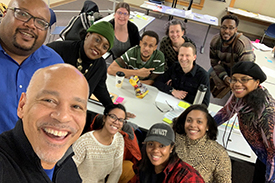Learn to Discern: Media Literacy Trainer's Manual

People are flooded with misinformation and manipulative content that drown out credible information. Our Learn to Discern approach teaches the skills that people need in order to identify and reject manipulative content and select credible, objective information.
The Learn to Discern: Media Literacy Trainer’s Manual (PDFs in English and Georgian) is a curriculum for educators in formal and informal education environments. It provides step-by-step guidance and interactive exercises for helping learners of all ages recognize why and how manipulative content works and gain skills to reject half-truths, clickbait, hate speech, and fakes. These issues are especially important for preventing the spread of COVID-19 and preparing citizens for elections.
Topics include:
- The information and media space and its features: Navigating different types of platforms and content, distinguishing between facts and opinions, recognizing professional journalism, and more.
- Misinformation and manipulation: Why everyone is vulnerable, and how to recognize and overcome biased information.
- Fighting misinformation: Practical skills and tools for recognizing and rejecting manipulation, assessing credibility, and selecting objective content.
To receive additional resources from IREX on teaching information and media literacy, sign up for updates.
How to use the manual
Educators can use the entire curriculum or choose the modules that work best for their context.
- To decide which modules would work best for your learners, go to the “Principles” section.
- To consider what modules would work best for your time frame, go to the “Choosing Lessons” section.
IREX offers training for educators who would like formal instruction in using the curriculum.
Methodology
This curriculum is based on our peer-reviewed and internationally recognized Learn to Discern approach to media and information literacy. It focuses on building the agency and skills of those who interact with information. It is not about prescribing a list of “good” or “bad” information sources or criticizing participants’ choice of news outlets.
Learn to Discern starts with building awareness of how the information space and its new features (such as speed, volume, and reach of information) interplay with human cognitive biases and emotional needs to produce filter bubbles, limit our choices, and push us into split-second decisions. It then gradually leads learners toward regaining control over their information space by honing their critical-thinking skills and abilities to identify and verify credible information. It concludes with building healthier information engagement habits, increasing demand for credible information, and strengthening participants’ commitment to sharing information responsibly.
By first grounding learners in their information environment and then exploring the biases that affect how they interact with information, this approach builds a foundation that allows for sustainable, long-term change.